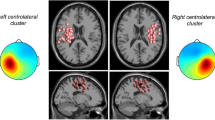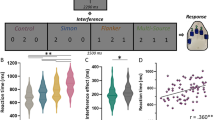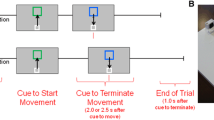Abstract
Post-movement beta synchronization (PMBS) modulations have been related to sensory reafferences after movement initiation and inhibitory processes after movement interruption. Although these processes have been separately studied in young and old adults, little is known about the age-related changes in PMBS during selective inhibitory control (i.e. stop a part of an action). The present study examines the age-related modulations of PMBS associated with sensory reafferences and inhibitory processes in selective inhibitory control. Young (n = 17) and old (n = 13) participants performed a switching task first engaging bimanual finger tapping then requiring to stop the left while maintaining the right unimanual tapping (i.e. selective inhibition) at an imperative stimulus. Age groups were compared on behavioral (mean, variability and percentage of errors of inter-tap interval during and after the switching) and electrophysiological (time–frequency and source estimations in the 14–30 Hz beta frequency range) data time-locked on the imperative stimulus. Behaviorally, old adults showed larger variability and percentage of errors during the switching but performed as well as young adults after the switching. Electrophysiologically, PMBS significantly increased after the switching in the old compared to the young group within bilateral frontal and parietal areas. Our results show that the effort to maintain selective inhibition involves increased brain activation in old compared to young adults. The larger PMBS within frontal and parietal regions in old adults may reflect an age-related brain compensation enabling to efficiently maintain post-switching inhibition.




Similar content being viewed by others
References
Addamo PK, Farrow M, Hoy KE, Bradshaw JL, Georgiou-Karistianis N (2007) The effects of age and attention on motor overflow production—a review. Brain Res Rev 54:189–204. doi:10.1016/j.brainresrev.2007.01.004
Aramaki Y, Honda M, Sadato N (2006) Suppression of the non-dominant motor cortex during bimanual symmetric finger movement: a functional magnetic resonance imaging study. Neuroscience 141:2147–2153. doi:10.1016/j.neuroscience.2006.05.030
Bangert AS, Reuter-Lorenz PA, Walsh CM, Schachter AB, Seidler RD (2010) Bimanual coordination and aging: neurobehavioral implications. Neuropsychologia 48:1165–1170. doi:10.1016/j.neuropsychologia.2009.11.013
Blais M, Martin E, Albaret JM, Tallet J (2014) Preservation of perceptual integration improves temporal stability of bimanual coordination in the elderly: an evidence of age-related brain plasticity. Behav Brain Res 275:34–42. doi:10.1016/j.bbr.2014.08.043
Bloom JS, Hynd GW (2005) The role of the corpus callosum in interhemispheric transfer of information: excitation or inhibition? Neuropsychol Rev 15:59–71. doi:10.1007/s11065-005-6252-y
Brunet D, Murray MM, Michel CM (2011) Spatiotemporal analysis of multichannel EEG: CARTOOL. Comput Intell Neurosci 2011:813870. doi:10.1155/2011/813870
Cabeza R (2002) Hemispheric asymmetry reduction in older adults: the HAROLD model. Psychol Aging 17:85–100. doi:10.1037/0882-7974.17.1.85
Cabeza R, Anderson ND, Locantore JK, McIntosh AR (2002) Aging gracefully: compensatory brain activity in high-performing older adults. Neuroimage 17:1394–1402
Coxon JP, Van Impe A, Wenderoth N, Swinnen SP (2012) Aging and inhibitory control of action: cortico-subthalamic connection strength predicts stopping performance. J Neurosci 32:8401–8412. doi:10.1523/JNEUROSCI.6360-11.2012
de Peralta Menendez RG, Andino SG, Lantz G, Michel CM, Landis T (2001) Noninvasive localization of electromagnetic epileptic activity. I. Method descriptions and simulations. Brain Topogr 14:131–137
de Peralta Menendez RG, Murray MM, Michel CM, Martuzzi R, Andino SLG (2004) Electrical neuroimaging based on biophysical constraints. Neuroimage 21:527–539. doi:10.1016/j.neuroimage.2003.09.051
Deiber MP, Ibanez V, Sadato N, Hallett M (1996) Cerebral structures participating in motor preparation in humans: a positron emission tomography study. J Neurophysiol 75:233–247
Dorfman LJ, Bosley TM (1979) Age-related-changes in peripheral and central nerve-conduction in man. Neurology 29:38–44
Duque J, Mazzocchio R, Dambrosia J, Murase N, Olivier E, Cohen LG (2005) Kinematically specific interhemispheric inhibition operating in the process of generation of a voluntary movement. Cereb Cortex 15:588–593. doi:10.1093/cercor/bhh160
Fling BW, Seidler RD (2012) Fundamental differences in callosal structure, neurophysiologic function, and bimanual control in young and older adults. Cereb Cortex 22:2643–2652. doi:10.1093/cercor/bhr349
Galganski ME, Fuglevand AJ, Enoka RM (1993) Reduced control of motor output in a human hand muscle of elderly subjects during submaximal contractions. J Neurophysiol 69:2108–2115
Goble DJ, Hurvitz EA, Brown SH (2009) Deficits in the ability to use proprioceptive feedback in children with hemiplegic cerebral palsy. Int J Rehabil Res 32:267–269. doi:10.1097/MRR.0b013e32832a62d5
Goble DJ, Coxon JP, Van Impe A, De Vos J, Wenderoth N, Swinnen SP (2010) The neural control of bimanual movements in the elderly: brain regions exhibiting age-related increases in activity, frequency-induced neural modulation, and task-specific compensatory recruitment. Hum Brain Mapp 31:1281–1295. doi:10.1002/hbm.20943
Grady CL, McIntosh AR, Horwitz B, Rapoport SI (2000) Age-related changes in the neural correlates of degraded and nondegraded face processing. Cogn Neuropsychol 17:165–186. doi:10.1080/026432900380553
Grady CL, Bernstein LJ, Beig S, Siegenthaler AL (2002) The effects of encoding task on age-related differences in the functional neuroanatomy of face memory. Psychol Aging 17:7–23
Grandjean J, Collette F (2011) Influence of response prepotency strength, general working memory resources, and specific working memory load on the ability to inhibit predominant responses: a comparison of young and elderly participants. Brain Cogn 77:237–247. doi:10.1016/j.bandc.2011.08.004
Guthrie D, Buchwald JS (1991) Significance testing of difference potentials. Psychophysiology 28:240–244
Haslinger B, Erhard P, Weilke F et al (2002) The role of lateral premotor–cerebellar–parietal circuits in motor sequence control: a parametric fMRI study. Brain Res Cogn Brain Res 13:159–168
Heuninckx S, Wenderoth N, Debaere F, Peeters R, Swinnen SP (2005) Neural basis of aging: the penetration of cognition into action control. J Neurosci 25:6787–6796. doi:10.1523/JNEUROSCI.1263-05.2005
Hoechstetter K, Bornfleth H, Weckesser D, Ille N, Berg P, Scherg M (2004) BESA source coherence: a new method to study cortical oscillatory coupling. Brain Topogr 16:233–238
Houdayer E, Labyt E, Cassim F, Bourriez JL, Derambure P (2006) Relationship between event-related beta synchronization and afferent inputs: analysis of finger movement and peripheral nerve stimulations. Clin Neurophysiol 117:628–636. doi:10.1016/j.clinph.2005.12.001
Hu S, Chao HH, Winkler AD, Li CS (2012) The effects of age on cerebral activations: internally versus externally driven processes. Front Aging Neurosci 4:4. doi:10.3389/fnagi.2012.00004
Krause BJ, Schmidt D, Mottaghy FM et al (1999) Episodic retrieval activates the precuneus irrespective of the imagery content of word pair associates. A PET study. Brain 122(Pt 2):255–263
Labyt E, Szurhaj W, Bourriez JL et al (2003) Changes in oscillatory cortical activity related to a visuomotor task in young and elderly healthy subjects. Clin Neurophysiol 114:1153–1166. doi:10.1016/s1388-2457(03)00058-0
Labyt E, Szurhaj W, Bourriez JL, Cassim F, Defebvre L, Destee A, Derambure P (2004) Influence of aging on cortical activity associated with a visuo-motor task. Neurobiol Aging 25:817–827. doi:10.1016/j.neurobiolaging.2003.08.010
Labyt E, Cassim F, Szurhaj W, Bourriez JL, Derambure P (2006) Oscillatory cortical activity related to voluntary muscle relaxation: influence of normal aging. Clin Neurophysiol 117:1922–1930. doi:10.1016/j.clinph.2006.05.017
Langenecker SA, Nielson KA (2003) Frontal recruitment during response inhibition in older adults replicated with fMRI. Neuroimage 20:1384–1392. doi:10.1016/s1053-8119(03)00372-0
Leocani L, Cohen LG, Wassermann EM, Ikoma K, Hallett M (2000) Human corticospinal excitability evaluated with transcranial magnetic stimulation during different reaction time paradigms. Brain 123:1161–1173. doi:10.1093/brain/123.6.1161
Mattay VS, Fera F, Tessitore A, Hariri AR, Das S, Callicott JH, Weinberger DR (2002) Neurophysiological correlates of age-related changes in human motor function. Neurology 58:630–635
Michel CM, Murray MM, Lantz G, Gonzalez S, Spinelli L, de Peralta RG (2004) EEG source imaging. Clin Neurophysiol 115:2195–2222. doi:10.1016/j.clinph.2004.06.001
Neuper C, Pfurtscheller G (1996) Post-movement synchronization of beta rhythms in the EEG over the cortical foot area in man. Neurosci Lett 216:17–20
Nielson KA, Langenecker SA, Garavan H (2002) Differences in the functional neuroanatomy of inhibitory control across the adult life span. Psychol Aging 17:56–71
Oldfield RC (1971) The assessment and analysis of handedness: the Edinburgh inventory. Neuropsychologia 9:97–113
Pfurtscheller G, Stancak A Jr, Neuper C (1996) Event-related synchronization (ERS) in the alpha band—an electrophysiological correlate of cortical idling: a review. Int J Psychophysiol 24:39–46
Pfurtscheller G, Neuper C, Andrew C, Edlinger G (1997) Foot and hand area mu rhythms. Int J Psychophysiol 26:121–135
Potter LM, Grealy MA (2008) Aging and inhibition of a prepotent motor response during an ongoing action. Neuropsychol Dev Cogn B Aging Neuropsychol Cogn 15:232–255. doi:10.1080/13825580701336882
Reuter-Lorenz PA, Jonides J, Smith EE, Hartley A, Miller A, Marshuetz C, Koeppe RA (2000) Age differences in the frontal lateralization of verbal and spatial working memory revealed by PET. J Cogn Neurosci 12:174–187
Sadato N, Campbell G, Ibanez V, Deiber M, Hallett M (1996) Complexity affects regional cerebral blood flow change during sequential finger movements. J Neurosci 16:2691–2700
Sailer A, Dichgans J, Gerloff C (2000) The influence of normal aging on the cortical processing of a simple motor task. Neurology 55:979–985
Sallard E, Spierer L, Ludwig C, Deiber MP, Barral J (2013) Age-related changes in the bimanual advantage and in brain oscillatory activity during tapping movements suggest a decline in processing sensory reafference. Exp Brain Res. doi:10.1007/s00221-013-3754-3
Sallard E, Tallet J, Thut G, Deiber MP, Barral J (2014) Post-switching beta synchronization reveals concomitant sensory reafferences and active inhibition processes. Behav Brain Res 271:365–373. doi:10.1016/j.bbr.2014.05.070
Salmelin R, Hamalainen M, Kajola M, Hari R (1995) Functional segregation of movement-related rhythmic activity in the human brain. Neuroimage 2:237–243
Schmidt D, Krause BJ, Mottaghy FM, Halsband U, Herzog H, Tellmann L, Muller-Gartner HW (2002) Brain systems engaged in encoding and retrieval of word-pair associates independent of their imagery content or presentation modalities. Neuropsychologia 40:457–470
Sebastian A, Baldermann C, Feige B et al (2013) Differential effects of age on subcomponents of response inhibition. Neurobiol Aging 34:2183–2193. doi:10.1016/j.neurobiolaging.2013.03.013
Serrien DJ, Swinnen SP, Stelmach GE (2000) Age-related deterioration of coordinated interlimb behavior. J Gerontol 55:295–303
Shaffer SW, Harrison AL (2007) Aging of the somatosensory system: a translational perspective. Phys Ther 87:193–207. doi:10.2522/ptj.20060083
Shannon BJ, Buckner RL (2004) Functional-anatomic correlates of memory retrieval that suggest nontraditional processing roles for multiple distinct regions within posterior parietal cortex. J Neurosci 24:10084–10092. doi:10.1523/JNEUROSCI.2625-04.2004
Solis-Escalante T, Muller-Putz GR, Pfurtscheller G, Neuper C (2012) Cue-induced beta rebound during withholding of overt and covert foot movement. Clin Neurophysiol 123:1182–1190. doi:10.1016/j.clinph.2012.01.013
Sommervoll Y, Ettema G, Vereijken B (2011) Effects of age, task, and frequency on variability of finger tapping. Percept Mot Skills 113:647–661
Stancak A Jr, Wackermann J (1998) Spatial EEG synchronisation over sensorimotor hand areas in brisk and slow self-paced index finger movements. Brain Topogr 11:23–31
Stancak A, Feige B, Lucking CH, Kristeva-Feige R (2000) Oscillatory cortical activity and movement-related potentials in proximal and distal movements. Clin Neurophysiol 111:636–650. doi:10.1016/S1388-2457(99)00310-7
Stebbins GT, Carrillo MC, Dorfman J et al (2002) Aging effects on memory encoding in the frontal lobes. Psychol Aging 17:44–55
Summers JJ, Lewis J, Fujiyama H (2010) Aging effects on event and emergent timing in bimanual coordination. Hum Mov Sci 29:820–830. doi:10.1016/j.humov.2009.10.003
Swinnen SP (2002) Intermanual coordination: from behavioural principles to neural-network interactions. Nat Rev Neurosci 3:348–359. doi:10.1038/nrn807
Tallon-Baudry C, Bertrand O, Peronnet F, Pernier J (1998) Induced gamma-band activity during the delay of a visual short-term memory task in humans. J Neurosci 18:4244–4254
Vallesi A (2011) Targets and non-targets in the aging brain: a go/nogo event-related potential study. Neurosci Lett 487:313–317. doi:10.1016/j.neulet.2010.10.046
Ward NS (2006) Compensatory mechanisms in the aging motor system. Ageing Res Rev 5:239–254. doi:10.1016/j.arr.2006.04.003
Wenderoth N, Debaere F, Sunaert S, Swinnen SP (2005) The role of anterior cingulate cortex and precuneus in the coordination of motor behaviour. Eur J Neurosci 22:235–246. doi:10.1111/j.1460-9568.2005.04176.x
Wishart LR, Lee TD, Murdoch JE, Hodges NJ (2000) Effects of aging on automatic and effortful processes in bimanual coordination. J Gerontol 55:85–94
Wu T, Hallett M (2005) The influence of normal human ageing on automatic movements. J Physiol 562:605–615. doi:10.1113/jphysiol.2004.076042
Acknowledgments
Cartool software has been programmed by Denis Brunet, from the Functional Brain Mapping Laboratory, Geneva, Switzerland, and supported by the Center for Biomedical Imaging (CIBM) of Geneva and Lausanne.
Author information
Authors and Affiliations
Corresponding author
Rights and permissions
About this article
Cite this article
Sallard, E., Tallet, J., Thut, G. et al. Age-related changes in post-movement beta synchronization during a selective inhibition task. Exp Brain Res 234, 3543–3553 (2016). https://doi.org/10.1007/s00221-016-4753-y
Received:
Accepted:
Published:
Issue Date:
DOI: https://doi.org/10.1007/s00221-016-4753-y




